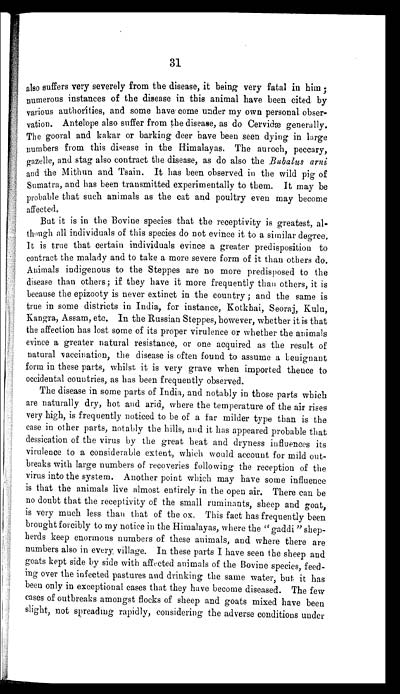Medicine - Veterinary > Civil Veterinary Departments > Civil Veterinary Department ledger series I-VI > Volume I - Rinderpest - cattle plague
(73) Page 31
Download files
Individual page:
Thumbnail gallery: Grid view | List view

31
also suffers very severely from the disease, it being very fatal in him ;
numerous instances of the disease in this animal have been cited by
various authorities, and some have come under my own personal obser-
vation. Antelope also suffer from the disease, as do Cervidæ generally.
The gooral and kakar or barking deer have been seen dying in large
numbers from this disease in the Himalayas. The auroch, peccary,
gazelle, and stag also contract the disease, as do also the Bubalus arni
and the Mithun and Tsain. It has been observed in the wild pig of
Sumatra, and has been transmitted experimentally to them. It may be
probable that such animals as the cat and poultry even may become
affected.
But it is in the Bovine species that the receptivity is greatest, al-
though all individuals of this species do not evince it to a similar degree.
It is true that certain individuals evince a greater predisposition to
contract the malady and to take a more severe form of it than others do.
Animals indigenous to the Steppes are no more predisposed to the
disease than others; if they have it more frequently than others, it is
because the epizooty is never extinct in the country ; and the same is
true in some districts in India, for instance, Kotkhai, Seoraj, Kulu,
Kangra, Assam, etc. In the Russian Steppes, however, whether it is that
the affection has lost some of its proper virulence or whether the animals
evince a greater natural resistance, or one acquired as the result of
natural vaccination, the disease is often found to assume a benignant
form in these parts, whilst it is very grave when imported thence to
occidental countries, as has been frequently observed.
The disease in some parts of India, and notably in those parts which
are naturally dry, hot and arid, where the temperature of the air rises
very high, is frequently noticed to be of a far milder type than is the
case in other parts, notably the hills, and it has appeared probable that
dessication of the virus by the great heat and dryness influences its
virulence to a considerable extent, which would account for mild out-
breaks with large numbers of recoveries following the reception of the
virus into the system. Another point which may have some influence
is that the animals live almost entirely in the open air. There can be
no doubt that the receptivity of the small ruminants, sheep and goat,
is very much less than that of the ox. This fact has frequently been
brought forcibly to my notice in the Himalayas, where the " gaddi " shep-
herds keep enormous numbers of these animals, and where there are
numbers also in every village. In these parts I have seen the sheep and
goats kept side by side with affected animals of the Bovine species, feed-
ing over the infected pastures and drinking the same water, but it has
been only in exceptional cases that they have become diseased. The few
cases of outbreaks amongst flocks of sheep and goats mixed have been
slight, not spreading rapidly, considering the adverse conditions under
Set display mode to: Large image | Zoom image | Transcription
Images and transcriptions on this page, including medium image downloads, may be used under the Creative Commons Attribution 4.0 International Licence unless otherwise stated. ![]()
| India Papers > Medicine - Veterinary > Civil Veterinary Departments > Civil Veterinary Department ledger series I-VI > Rinderpest - cattle plague > (73) Page 31 |
|---|
| Permanent URL | https://digital.nls.uk/75515987 |
|---|




